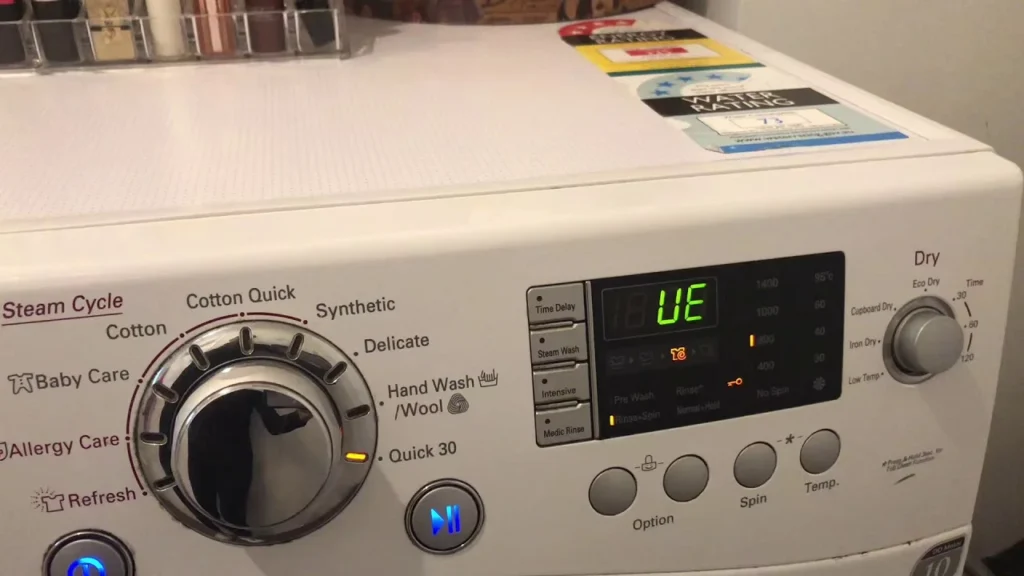
Dealing with error codes in home appliances can be frustrating. The UE code in LG washers indicates an unbalanced load, causing the machine to not spin or drain. While rebalancing clothes may fix it, other faults can also trigger this error. This guide walks through steps to diagnose and resolve UE issues, starting with basic troubleshooting and moving to examining internal components. Follow along to learn how to fix your washer or determine if replacement is needed.
Step 1: Try to Balance the Load
First try to balance the load in the drum of the washing machine. Open the hatch and examine exactly how the laundry is distributed inside. Notice if there are any tangled sheets, blankets, or other large items that can cause one-sided heaviness. Also check to see if you’ve washed too few items – small loads also cause imbalances.
If you find potential sources of imbalance, try to redistribute the laundry evenly across the drum. Unwrap tangled items, straighten creases. If you have a small load, add a few more items so that the weight is evenly distributed as the drum rotates.
After balancing, close the hatch and start spinning – this may be enough to clear the UE error. If not, proceed to the next diagnostic steps.
Step 2: Check the Washer Legs
Checking the legs of the washing machine is an important step when the UE error occurs. The fact is that if the washing machine is not level, the drum rotation will cause vibration and imbalance.
To check if the machine is installed, use a construction level. Put it on top of the washing machine cover and see if the bubble in the center of the level coincides with the zero mark. If not, the machine is not level and the feet need to be adjusted.
Rotate the feet to level the washing machine so that the level shows that it is level. Also make sure that all the feet are firmly in contact with the floor and do not “wobble”.
After adjusting the feet, start the spin cycle again and check if the error disappears. If the problem persists, continue with the step-by-step diagnosis of other possible problems.
Step 3: Reset the Washer
The next logical step in diagnosing the UE error is to simply reboot the washing machine. The fact is that sometimes there are failures in the operation of electronics, due to which the machine incorrectly detects the presence of imbalance. Rebooting helps to “restart” the control system and eliminate such situational failures.
To reset, disconnect the washing machine from the electricity supply – remove the plug from the socket or disconnect the circuit breaker at the switchboard. Wait a couple of minutes for the controller to perform a complete reinitialization. Then apply power again and start the spin cycle. This may make the UE error go away. If not, the problem is more serious and requires diagnostics of other components.
Step 4: Check the Internal Components
After checking simple external factors such as balancing the laundry and aligning the washing machine, the next logical step is to diagnose the internal components. Unfortunately, this is already a more complicated procedure that requires safety and home appliance skills.
First of all, make sure the washing machine is disconnected from electricity – this will eliminate the risk of electrocution. Then remove the side panels to access the insides. Depending on the model, check the condition of the rotor, suspension rods, shock absorbers and Hall sensor. Inspect the parts for mechanical damage, wear, loose fasteners. If necessary, replace failed components. This will help eliminate imbalance and UE error.
Step 5: Check the Hall Sensor
The Hall sensor detects the speed and position of the drum. If it is malfunctioning, the machine may erroneously detect an imbalance. Find the location of the sensor in the instructions for your model. Check the resistance at its terminals with an ohmmeter. If it is open or shorted, replace the sensor.
Step 6: Replace the Control Board
If the previous steps did not help – you will have to replace the control board. However, the cost of this procedure is comparable to half the price of a new machine.
Step 7: Consider Buying a New Washer
At the final stage, it makes sense to consider buying a new device, especially if your machine has already served a few years. This may be cheaper than repairing the control board.
